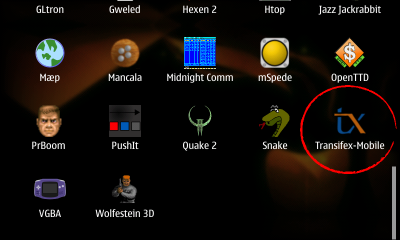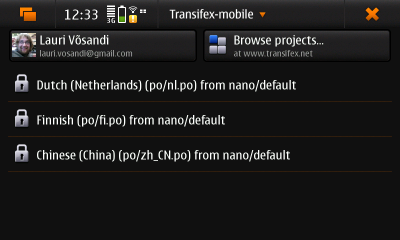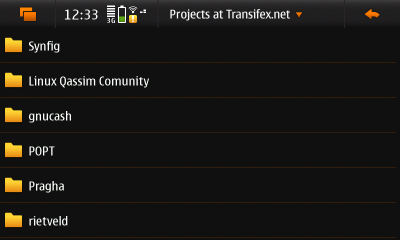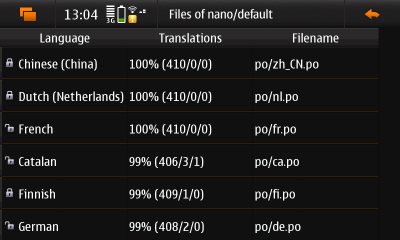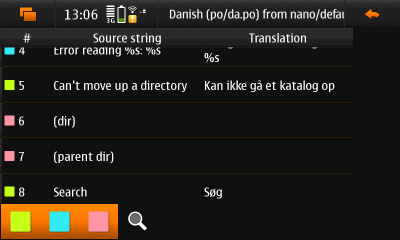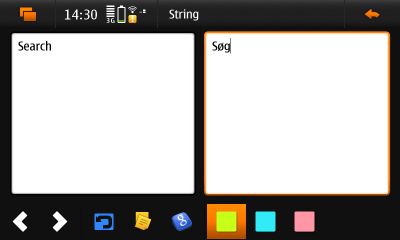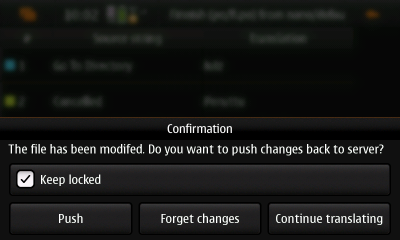GSoC 2010/Projects/transifex-mobile/manual
Contents |
Intro
Transifex-Mobile is a mobile localtraization application linked to translations portal Transifex.net. (FIXME: For which platform? Which license? Written in what language? Using which UI framework? Created as part of Maemo@SoC2010, etc.. - even if it is "kind of" clear through the placement in the Wiki, etc..)
FIXME: Add "what it is" and "what it is not" in list form, e.g. it's a tool to do translations of texts that appear in applications, but it's not an automated translation tool (the user has to do the translation manually, though maybe supported), it's a tool to do app translations, but it's not a tool for document translation, it works with .po files and transifex, but does not work yet with other services, it works with applications that are prepared for translation, but it does not work with applications that do not support gettext translations, ...
Installation
- Start Application manager
- Enable Maemo Extras repository
- Tap on "Download"
- Tap on "Development"
- Tap on "Transifex-mobile" to install it
- Icon with title "Transifex-Mobile" should appear in the menu, use it to run the application
Usage
Icon
After installing the icon should appear in the menu, tap it to start the program
Dashboard
The main screen mimics Transifex's dashboard view. The user can see her locks (FIXME: Describe locks a bit more in detail - what are they, how are they created, how can they be "removed", etc..) there, browse projects etc. Left-top button shows user's first and last name plus e-mail address. Verify that those are correct before pushing any files back to server (FIXME: Why? What are the problems if the user does not, what are the beenfits if (s)he does?). PO-file (FIXME: What is a PO file? Where does it reside in the project source tree? Does the user have to know?) metadata is updated based on this information. Editing local PO-files (FIXME: What does this mean? When is it useful? Where to get .po files from application developers?) is also enabled, just tap on "Open local file" in the menu (FIXME: tell the user that the menu can be reached by tapping the title bar).
FIXME: What happens if the user touches a row in this view?
Projects
(FIXME: How does the user get here? By clicking on the button...)
Browsing projects is rather straightforward, to search tap on "Search" in the menu (FIXME: ... from the title bar).
FIXME: What happens if the user touches a row in this view?
Files
Each component in a project contains files, or translations to be more abstract. File list view shows progress for each file.
FIXME: What do the three numbers in brackets in the "Translations" column stand for?
FIXME: What happens if the user touches a row in this view?
Strings
Each file contains a set of strings. In the left-bottom corner there are some buttons for filtering. A string can have three statuses - green means translated string, red means not translated and blue is used mark fuzzy strings, this means that the string is basically translated but might need to be checked one more time.
FIXME: I would place the "status" description (red, green, blue) in a table here, and have not only the textual description, but also a square colored in the specific color (you can do this by embedding the icon, etc..). This makes the description stand out more and makes it clearer to the user which is which.
FIXME: What does the magnifying glass icon do?
FIXME: What happens if the user touches a row in this view?
String editor
String editor view provides all the things you need to translate one string. With the buttons on the bottom user can navigate through strings in the current stringset, revert back to the original one, copy source string, use Google Translate to automatically translate the string and finally set the string status either to translated, fuzzy or untranslated.
FIXME: Also here, it would be nice to have a table of toolbar icons with their description. (i.e. one row with the left arrow icon and its description what it does, the next row with the right arrow icon and its description what it does, etc..) "Copy source string" could be better described as "copy the text from the left text area into the right text area" (if that's what it does - it could also mean that the text in the left pane is copied to the clipboard).
Push dialog
Upon closing the string list view user is confronted with push dialog. Here user can select whether changes are to be pushed back to server, or to be forgotten. Remember to unlock the file once you have finished translating. (FIXME: Why? What happens if the user does not do it? When should the user not unlock the file? How will the user be able to continue translating the file if it's locked? How can the user unlock the file if (s)he has accidentally left it locked?)
Debugging
FIXME: I would rename this section "reporting problems and bugs", with the link to the TMO thread at the top and then a sub-section called "how to obtain debugging output" with the info from here.
To start Transifex-Mobile in debugging mode, fire up terminal and execute following command:
/opt/transifex-mobile/main.py -d
Transifex-Mobile configuration file is located at:
~/.config/transifex-client.json
Cached PO files are stored in:
~/.cache/transifex-mobile
You can report bugs in this Maemo Talk thread, please include debugging output.

